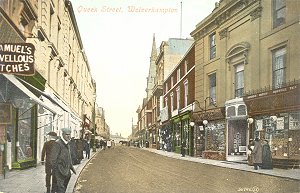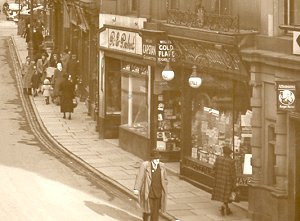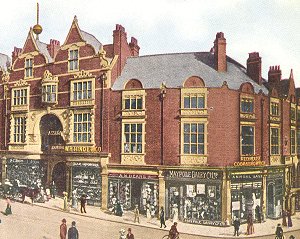| The origins of the Maypole Dairy chain are in a
family provision business. Their specialism was in dairy produce
such as butter and lard and, importantly, in the development of
the use of margarine, which was going to be called butterine
before a legal action prevented it in 1887.
The Watson family owned a provision business in Birmingham in
the early 1800s. George Jackson took over this business in 1859,
trading as Medova Dairies. Three Watson brothers were
apprenticed to him. However they split up because George Jackson
did not want to threaten his butter trade by introducing
competition from sales of margarine, which was looked upon with
suspicion at the time as an inferior product for the lower
classes.
George Watson decided to set up his own business in 1887 and
opened the first shop of the Maypole Dairy Company at 67 Queen
Street, Wolverhampton.
 |
In this postcard
(postmarked 1908) Maypole Dairies' original branch can
be seen at the right hand edge, almost on the corner
with Dudley Street. |
His brother Charles opened a Danish dairy in Wednesbury at
about the same time, eventually setting up headquarters in
Manchester in 1889.
The brothers, plus Alfred Watson, combined forces with George
Jackson and Medova in 1898. Their shops specialised in butter
and margarine, not milk. There was an agreement between Maypole
and Medova not to compete in the same towns.
| In this detail from
a postcard of about 1950 the shop is still in Queen
Street, with the two globe lamps, marked "Maypole", and
the shop front unaltered. |
 |
Alfred opened the shops in the midlands, and
Charles did likewise in the north. The Medova chain run by
Jackson concentrated in the south and east.
Maypole quickly became a household word in the
country for dairy produce. There were soon 105 Maypole shops to
80 Medova ones. Large cities such as Manchester, Glasgow and
Edinburgh had multiple branches.
The Watsons had strong links with Danish dairy
suppliers, who had a rapidly growing share of the UK market in
butter. They set up their own food transit depots in Denmark.
 |
The Queen Square
branch, shown in a detail from a postcard postmarked 1910.
Presumably Maypole moved into these buildings as soon as
they were built. |
The number of Maypole branches had reached 985 by
1915. The 1000th shop opened in 1926. The success was
due in large part to the growing popularity of margarine and
their insistence on high quality despite all their products
being mass trade. The Watsons supplied one third of the UK
margarine market by 1914. Cheese was dropped early on and the
main trade was in five products: eggs, tea, condensed milk,
butter and margarine.
| The blind of the Queen
Square branch can just be seen on the right hand edge of
this undated postcard. This branch and the original
one in Queen Street seem to b the only two branches Maypole
ever had in their home town, Wolverhampton. |
 |
A battle for the UK margarine industry had taken
place between Maypole and two Dutch firms, Jurgens and van den
Berghs. Home and Colonial, supplied by Jurgens, and Lipton,
supplied by Van den Bergh, who introduced Blue Band, became the
main rivals to Maypole in the margarine trade. A price war
developed between them.
On top of this the margarine bubble was deflating
by the 1920s when it became cheaper to import foreign margarine
than to make it. Investments by Maypole in groundnut oil from
Africa had turned sour and profits were falling. By 1924 Maypole
gave in and ownership of the share capital moved from the Watson
family to Home and Colonial Stores.
The chain continued to trade under the same name
however and started to diversify its products. After many more
years of trading, in 1964 Pearks, Maypole, Home and Colonial and
Liptons, who were all trading as branches of Allied Suppliers,
came together to share the same headquarters in London, and most
functions of the group were centralised, bringing to an end the
separate management structures of each of the companies.
|